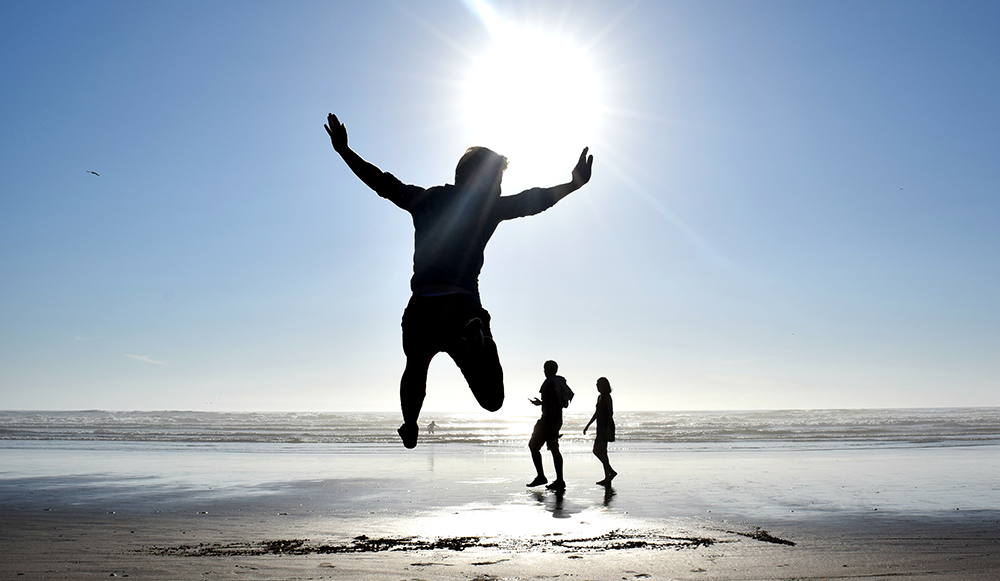Go With Your Gut: The Science of Instinct

Article by Shelley Levitt
“I had a feeling about it.”
“I just knew.”
“It was a hunch.”
“My intuition told me.”
“I acted on instinct.”
“I felt it in my gut.”
We’ve all had these experiences countless times in our lives. It happens when we’re interviewing a potential hire or being interviewed ourselves. It happens when we’re sizing up a potential business partner or new client. It happens when we walk into a restaurant and catch sight of our blind date at the bar, or when we cross the threshold into the two-story colonial our real estate agent has assured us “is just perfect” for us.
We’re gripped by a powerful, visceral feeling, a deep sense of certainty that tells us what to do: Hire the guy. Don’t take the job. Move forward with the deal. This is the person you’re going to marry. Make an offer on the house.
And years later, when we tell the story, we’ll say it was the best decision we ever made.
Good thing we listened to our gut.
The Power of Instinct
The phenomenon we often refer to as “gut instinct” has been studied by a broad range of experts, including psychologists, economists, microbiologists, and sociologists. When it comes to all this research, there’s widespread agreement on a couple of points.
First, our gut instinct isn’t some magical, mystical force. Rather, says cognitive psychologist Gary Klein, Ph.D., author of Sources of Power: How People Make Decisions and The Power of Intuition , “It’s the way we translate our experience into judgment and actions.”
When Klein studied how individuals such as firefighters and emergency medical personnel make instant life-or-death decisions, he found they were able to size up situations rapidly by picking up on subtle cues, patterns, and anomalies. Then, they would take decisive action without having to stop and conduct deliberate analysis. Psychologist Daniel Kahneman, who was awarded the 2002 Nobel Memorial Prize in Economic Sciences for the pioneering work he did in decision-making, called this “System 1” thinking. It’s fast, instinctual, and emotional.
The second accepted fact is that we couldn’t survive without our gut feelings.
“More than 99 percent of the decisions we make every day, we make without deliberation,” says Carl Spetzler, Ph.D., cofounder and CEO of Strategic Decisions Group, a strategic management consulting firm headquartered in Palo Alto, California. He’s also lead author of the new book Decision Quality: Value Creation from Better Business Decisions .
Those automatic decisions – what Malcolm Gladwell called “thinking without thinking” in his best-selling book Blink – include everything from choosing which foot to start with when you walk to hitting the brakes when you see a line of cars stopped in front of you on the highway or grabbing your 1-year-old when she begins tumbling off the sofa.
If you think you’d make better choices if emotions didn’t get in your way, think again.

On the other hand – and there’s always another hand in the realm of decision-making – relying on your gut alone is a pretty efficient formula for wrecking a business, a marriage, or a life. In their groundbreaking work, Kahneman and his late partner Amos Tversky discovered that intuitive thinking without further reflection is oftenfaulty thinking. Numerous biases are at play when we make fast decisions under conditions of uncertainty. To cite just a few:
– We tend to have an “optimistic bias,” believing we’ll succeed in the face of long odds.
– We place more faith in things we’ve heard about recently than in events that happened years ago and are less easy to remember; that’s called “availability bias.”
– Vivid occurrences are also more likely to influence us, which is why we typically overestimate the number of people killed in plane accidents and underestimate fatalities from car crashes.
– “Confirmation bias” means we often ignore information that doesn’t support our existing beliefs and give too much weight to data that’s in sync with our current mindset.
– In “hindsight bias,” or the “I-knew-it-all-along effect,” we imagine that we were better at predicting, say, the ups and downs in our industry than we actually were.
Put all these biases together, and we end up with what Kahneman calls “WYSIATI,” an acronym for “what you see is all there is.” That’s the unconscious conviction that everything we need to make a decision is right in front of us. After all, we feel it in our gut.
Paying attention to your gut, most experts would agree, is a valuable first step in reaching a decision. But unless the decision involves something like picking out a puppy from a litter, you’ll want to combine your gut instinct with more effortful and logical deliberation, which Kahneman calls “System 2” thinking. If System 1 provides a fast-and-furious first draft, System 2 hones that draft into a professional PowerPoint presentation. It’s slow, deliberate, and rational.
Talking Back to Your Gut
You don’t want to take what your gut is telling you at face value. Instead, you need to investigate what’s driving your first impression. Psychologist Bruce Pfau, Ph.D., is a New York-based senior partner at KPMG, one of the Big Four auditors, where he advises C-suite executives on human resources strategies and communications.
“What we label a gut feeling is always based on a set of variables that we haven’t spent time articulating,” Pfau says. “Only when you bring those facts into the light of day can you analyze them objectively and dispassionately and move on to making a good decision. ”
If you’re considering forming a partnership with somebody but have a nebulous feeling of unease, Pfau suggests free-associating: “Let your mind start putting words to what it is about this person that’s making you uncomfortable. It can start with something vague, [like] ‘I just have the feeling he’s not going to be a good partner.'”
Dig deeper. Ask yourself, What about him is making me feel that way? Does he seem too complacent? Too argumentative? Is it something in his body language? Something he said or the way he said it? It might be helpful to jot down notes or enlist someone else as a sounding board to guide your reflection. Then test your feelings against available data.
Decision-Making in the Real World
Larry Gadea is the founder and CEO of Envoy, a San Francisco-based company that helps businesses replace paper sign-in books with iPad-based visitor registration.

It’s taken him awhile to get used to that. Gadea is a data guy. He spent four years as a systems engineer at Google, where “everything was measurable,” he says. “If the server took another 15 milliseconds processing a request, it could mean a loss of $50 million over the year.” Being an engineer, he says, “was all about making the perfect decision, not the good-enough decision.”
A few years ago, when Envoy was raising money, the company was in the fortunate position of having several interested investors.
“They were all top-tier, awesome, super smart people who knew what’s up,” Gadea says.
As always, Gadea had done his homework, but the copious research he’d gathered on each investor wasn’t helping him move past indecision. So he let his gut make the final call.
“I asked myself, ‘If I ever had to tell somebody bad news, who would help me?'” Gadea explains.
His intuition pointed to a clear winner: Chris Dixon, a general partner in Andreessen Horowitz, a Menlo Park, California-based venture capital firm. Dixon had, aptly enough, once launched a company called Hunch that was sold to eBay.
“I really like Chris; we have a lot in common and we get along really well, so it turned out to be a great decision,” Gadea says. “If I had overanalyzed it, who knows what micro-optimization I might have gone with that would make things much less enjoyable.”
“Your feelings aren’t random,” Pfau says. “They’re based on something that’s observable and measurable, but you can’t take reliable action until you start identifying what that is.”
You might ultimately come to realize your reaction is actually rooted in something not entirely rational. Perhaps Joe is setting off alarms because something about him reminds you of Warren, the kid who bullied you in junior high school. Once you’ve made that connection, Pfau says, you can eliminate the discomfort from your assessment.
Despite his training as an engineer, Gadea was still connected to his “feeling” brain. For some people who are by nature deeply analytical, that can be a challenge.
“Everyone has a preferred approach to decision-making based on personality type,” says Spetzler. “It’s important not to let our preference-based habits get in the way of solving the problem that needs to be solved.”
Spetzler says his firm is hired to help clients make big strategy choices, such as whether they should spend $5 billion on an underwater deep-seas project amid geological, geopolitical, and economic uncertainty.
“If they make the wrong decision, they’ll never recover,” Spetzler says. “So people on my staff might spend months doing research and developing a decision tree that has thousands of branches.”
Well trained in System 2 thinking, analytical types can get stymied when it comes to making inconsequential decisions.
“It’s always funny to watch some of my people deciding where to go to lunch,” Spetzler says. “They look at too many alternatives. They want to pick the single best place. They’re caught in the extreme opposite of intuitive processes, and it really slows them down. Our culture is a collaborative one, but at some point I have to say, ‘C’mon guys, it’s just lunch. Let’s go.'”
If this sounds like you, a couple of approaches can help you speed up the less momentous decisions in your life. First, ask yourself how much time you’re going to commit to making the decision: 10 minutes to choose where to go for drinks with colleagues; eight hours over the next week to pick a place for the holiday office party; two Saturday afternoons to research and test mattresses. Still can’t decide between an innerspring and the memory foam model? The gut feeling you have at the deadline can clarify your final pick.

Julie Benezet is a lawyer, entrepreneur, former Amazon executive, and now a leadership coach to top executives.
“I always tell my clients it’s good to have a bright analytical brain, but at the end of the day, the stomach is the smartest organ in the body. It houses life experiences, values, and inconvenient truths,” Benezet says.
When you’re wrestling with a decision, the message your gut is sending can be muffled by emotion or urgency. Ask yourself these questions to help you make the best use of your gut wisdom:
– Am I really paying attention to what my gut is telling me about a decision, or am I rushing to judgment to stop feeling anxious?
– Am I listening to my gut because I’m feeling lazy about supporting my feelings with facts, or do I really feel I know enough to make a call?
– If I sit with this gut feeling for a few minutes and allow my head to kick in, will I allow my gut feeling to change?
– Is my gut telling me what I believe to be true based on what I either know or can find out, or am I paying more attention to the truths of others?
– Do I know enough about the decision to be able to defend it beyond saying “Trust me” if challenged by others?
– Is the information I am collecting to test my gut reaction causing my gut to become calm, or is it giving my gut a flat or troubled feeling?
Finally, Klein offers advice that might seem counterintuitive. When we have two hours to meet a deadline on reaching a decision, most of us will take care of other pressing business first, like making essential calls or answering emails that require immediate attention. We want to clear the decks so we can focus solely on the pending decision – but that doesn’t allow our gut to work on the problem in the background.
“You’re not giving yourself any time for incubation,” Klein says. “I’d suggest the reverse order: Immerse yourself in the project, and then take a timeout to deal with something else.”
Klein says your subconscious will be “chewing on your decision” while you’ve shifted your priorities, which just might provide the moment of “aha!” clarity you need.
A version of this article originally appeared in the November 2016 issue of SUCCESS magazine and on SUCCESS.com.

